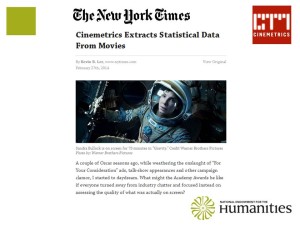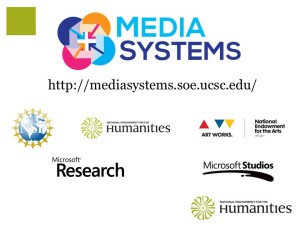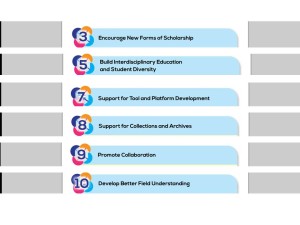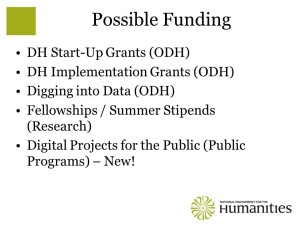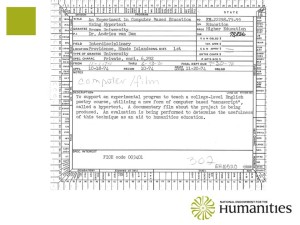SCMS 2014: Digital Humanities & Media Studies: Exploring the Intersections
I was pleased to attend the annual meeting for the Society for Cinema and Media Studies recently, where I organized a workshop on the topic of “Digital Humanities & Media Studies: Exploring the Intersections.” This talk deliberately built on the session from last year, organized by Miriam Posner and Jason Mittell, on “DH & Media Studies: Staging an Encounter” and the MediaCommons’ Front Page Survey Question from April 2013: “What are the differentiations and intersections of media studies and the digital humanities?“ (You can read my answer to that question in my response “The Boolean Logic of the Digital Humanities.”)
Whenever discussing the ways in which digital humanities intersects with any discipline, my preference is to root the discussion not in the abstract, but rather to embed our theorization of that work in specific examples. I was very happy, then, to be joined by representatives of four specific projects that operate in this space where DH meets media studies. All four workshop participants have received support for their work through an NEH Digital Humanities Start-Up Grant. Participants included Anne Balsamo (Dean of the School of Media Studies at the New School for Public Engagement; AIDS Memorial Quilt Digital Experience Project), Dene Grigar (Associate Professor and Director of The Creative Media & Digital Culture Program at Washington State University Vancouver; Pathfinders: Documenting the Experience of Early Digital Literature), Eric Kaltman(graduate student in Computer Science at UC Santa Cruz’s Expressive Intelligence Studio; Preserving Cultural Software, with Noah Wardrip-Fruin, Henry Lowood, and Christy Caldwell), and Lauren Klein (Assistant Professor in the School of Literature, Media, and Communication at Georgia Tech; TOME: Interactive TOpic Model and MEtadata Visualization).
I opened the panel with the following remarks. [Note that the content that follows reflects my opinion and should not be taken as official NEH policy.]
Digital Humanities and Media Studies: Exploring the Intersections
Thank you for joining us here today, on the final day of the conference.  I’m very happy to have here this wonderful group of workshop participants who represent points of intersection between media studies and this eclectic set of activities that has been largely gathered under this rubric “digital humanities.” This panel, and its subtitle “Exploring the Intersections,” deliberately builds on a panel organized last year by Miriam Posner and Jason Mittell (that one was entitled “Digital humanities and media studies: staging an encounter“).
Posner opened this previous session by way of Johanna Drucker, who asserted that “We must theorize digital technology through critical engagement with the medium itself, through making and breaking and building and reflecting,” an observation that mirrors Tara McPherson’s own calls for the “multimodal scholar,” one that is likely drawn from the ranks of media studies, because, as she writes, “Who better to reimagine the relationship of scholarly form to content than those who have devoted their careers to studying narrative structure, representation and meaning, or the aesthetics of visuality? Who better to address the utopian registers of much popular commentary on technology than historians of media and scholars of political economy?”
Who indeed?
Posner closed her remarks last year with the following: “I urge us to see this as an opportunity to draw on those qualities at which media studies excels…and to ask what they can bring to the digital humanities.”
Our guiding subtitle today–exploring the intersections–is also meant to suggest that: firstly, digital humanities has no clear definition, nor is its history or origin to be found in a single discipline or approach, and secondly, that DH might best be considered, as many have suggested, as a community–or better yet, communities–of practice, which constitute a fairly broad “possibility space” of intersecting points along three vectors (following Etienne Wenger):
with overlapping domains of expertise and knowledge bases across the different disciplines;
overlapping communities of scholars — the actual people and their interaction, be it online, on campus, or in shared convention halls;
and, overlapping practices–the variable methodological and theoretical approaches that comprise ways of doing research.
Are you a tweeting, social network analyzing media scholar from the SW, with memberships in SCMS and AoiR and HASTAC? Or, are you a geospatially-oriented film scholar from a NE liberal arts campus with membership in SCMS, MLA, and CAA, with a love of Facebook, a disdain for twitter, and an irrational fear of blogging? As Katie King argues “movement among knowledge worlds require understanding authorships, audiences and agencies in ways that keep redrawing forms of inclusion and exclusion, virtually moment to moment,” and I believe this informs the ways that the phrase ‘digital humanities’ can either feel inclusive or alienating at any given time to any give person engaged in work along these multiple vectors in this possibility space.
With so many concerns about what counts, who’s in and who’s out, and so on, I think it reassuring that this formation of a “possibility space†is a process of dynamic iteration that should open possibilities rather than foreclose them. For better or worse, an arrangement of these vectors often manifests most readily in the form of a project, which serves as a kind of defining entity of DH, containing the domains, collaborative groups, and practices that inform them. Scholars and their projects in media studies that share one very particular kind of vector — support through NEH funding — include some of the following:
MediaCommons  was one of our earliest Start-Up Grants and is itself a sort of gathering of intersecting vectors– a social network supporting a community of practice, and offering mechanisms like the Survey Questions for theorizing the different inflection points shaping media studies. Of course, MediaCommons became a model for recasting online scholarly communities and methods of publication, offering a legacy that traces down to sites like MLA Commons.
Project Arclight, funded through a Digging into Data grant, and presented here yesterday by Eric Hoyt.
And also presenting yesterday, Michael Casey (Bregman Music & Audio Research) and Mark Williams (Film and Media Studies) from Dartmouth with the ACTION toolkit for cinematic information retrieval.
Scalar and Vectors, which received programming support under the auspices of three different Institutes for Advanced Topics in the Digital Humanities (Tara McPherson & her team remain, I think, the group that has received the largest sum of funding from the Office of Digital Humanities).
Grant support has been provided to those studying the history of various types of film, like Kevin Hamilton’s (University of Illinois) project: Online Video Archive & Prototype Interface for America’s Nuclear Test Films.
Or Yuri Tsivian’s (University of Chicago) Cinemetrics project, which analyzes shot length in cinema, and was featured in recent Oscar coverage in the New York Times.
We’ve been actively engaged in exploring DH as a possibility space.  Media Systems, a workshop jointly supported by NEH, NEA, NSF, and Microsoft Research, was held last year at UC Santa Cruz, led by Noah Wardrip-Fruin and Michael Mateas, in order to address this very problem of fostering a productive, overlapping community of practice centered on computational media. They brought in developers of technical systems, media scholars that study those systems, and artists/designers who create using them. You can read the final report online—newly released this week, so I encourage you to take a look.
There are a number of funding opportunities that support the study of media and film. Â You’ve heard about several DH Start-Up Grants, but other funding sources include the DH Implementation Grant program, Digging into Data, Fellowships & Summer Stipends (for that article or book project), Media Projects (for documentary films and radio), and the new Digital Projects for the Public.
In fact, we’ve been doing a little digging and have found several projects that reach back into some of NEH’s earliest history that support similar kinds of media work – this is a McBee record card from 1974, detailing a grant to Andy van Dam (Brown University) in “computer/film” for “an experimental program to teach a college-level English poetry course, utilizing a new form of computer-based ‘manuscript,’ called a hypertext.”
Today, we have four scholars who have worked under the auspices of digital humanities, in as much as they received funding for projects from the Office of Digital Humanities, although I’m not sure many of them would readily or quickly identify themselves first-and-foremost as “DH’ers” per se (which is, by the way, not a requirement in order to receive a grant), but found themselves in this possibility space of intersecting vectors.
First, we’ll hear from Anne Balsamo. She is the Dean of the School of Media Studies at the New School for Public Engagement. Her recent book, Designing Culture: The Technological Imagination at Work (Duke, 2011) examines the relationship between culture and technological innovation. Previously she was a Full Professor at the University of Southern California with joint appointments in the Annenberg School of Communication & the Interactive Media Division of the School of Cinematic Arts.
Dene Grigar is an Associate Professor and Director of The Creative Media & Digital Culture Program at Washington State University Vancouver who works in the area of electronic literature, emergent technology and cognition, and ephemera. She is the author of net art works, multimedia performances and installations, and nonfiction mobile projects like “Fort Vancouver Mobile.” She is President of the Electronic Literature Organization and Associate Editor of Leonardo Reviews.
Eric Kaltman is a graduate student in Computer Science at UC Santa Cruz’s Expressive Intelligence Studio. He was a member of the Preserving Virtual Worlds II project team, which investigated archival significant properties for computer games. From 2008-2012 he was a project archivist for the digital games collections at Stanford University, cataloging and archiving the Cabrinety Collection and Steve Meretzky’s Infocom Papers. He is currently a member of an IMLS-funded grant focused on videogame metadata and citation practices.
Lauren Klein is an assistant professor in the School of Literature, Media, and Communication at Georgia Tech, where she also directs the Digital Humanities Lab. Her writing has appeared in American Literature, American Quarterly, and In Media Res. The recipient of a NEH Digital Humanities Start-Up Grant, she is at work on a tool that will allow scholars to visualize text-based archives, as well as a book on the cultural history of data visualization from the eighteenth century to the present day. (This visualization is based on her article The Image of Absence: Archival Silence, Data Visualization, and James Hemings,’ which was published in the December 2013 issue of American Literature).
I’ve asked each of the workshop participants to speak for around 7-8 minutes, and I hope what follows is a conversation about both pragmatic and theoretical aspects of ‘doing DH,’ whatever that might mean.
What followed was a dynamic conversation about both the pragmatics and the theory informing each of these DH projects, the possible value of using DH to approach media objects, and the many ways that media studies can inform and challenge our understanding of the digital humanities. Â I’m grateful to the workshop participants and the audience for a dynamic and exciting two hours.
Archives
- February 2016
- April 2014
- March 2014
- April 2013
- March 2012
- January 2012
- March 2011
- February 2011
- February 2009
- January 2008
- September 2007
- June 2007
- May 2007
- April 2007
- March 2007
- February 2007
- January 2007
- December 2006
- November 2006
- October 2006
- September 2006
- August 2006
- July 2006
- June 2006
- April 2006
- March 2006
- February 2006
- January 2006
- December 2005
- November 2005
- October 2005
- September 2005
- August 2005
- July 2005
- June 2005
- May 2005
- April 2005
- March 2005
- February 2005
- January 2005
- December 2004
- November 2004
- October 2004
- September 2004
- August 2004
- July 2004
- June 2004
- May 2004
- April 2004
- March 2004
- February 2004
- January 2004
- December 2003
- November 2003
- October 2003
- September 2003
- August 2003
- July 2003
- June 2003
- May 2003
- April 2003
- March 2003
Categories













